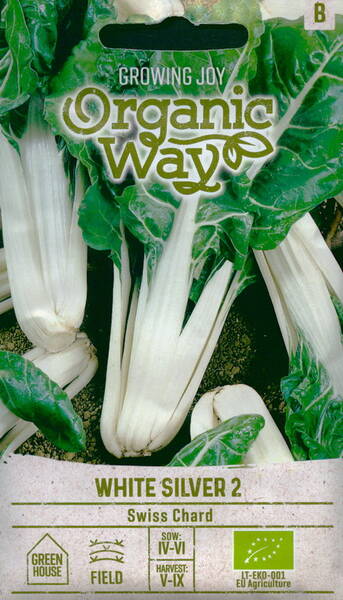Ex Tax: 0.75€
Mid-season variety (from germination to ripening 80-90 days). Beets are decorative and tasty, the leaves are eaten. The optimum temperature for germination is + 20 + 22 ° C. Seeds are sown in April-May.
1,0 g = 40-55 seeds.
* Chard is a cold hardy plant. Seeds begin to germinate at a temperature of +6+7°C. However, frosts (down to -3°C) can damage seedlings. The optimum temperature regime for plant growth and development is +17+23°С.
Chard is sown annually, but, sprinkled with earth and covered with spruce paws, it can winter in the ground. New shoots will appear in the spring.
You can grow leaf beets as a second crop. In this case, it is sown in the last days of August - the first days of September in the same way as in April. For the winter, the plants are sprinkled with earth and covered with needles. The next year, the leaves are harvested until mid-summer, until the plant forms a seed shoot.
Care, watering, feeding and harvesting.
Chard is not very picky about care. Since the leaf beet seed is a "glomerular seed" in which there are 2-3 or more seeds enclosed in a common shell, the chard crops need to be thinned out. The first thinning is carried out when 2-3 true leaves develop (15 cm are left in the row between plants).
The second thinning is done two weeks after the first. The distance between plants when thinning petiole varieties is left 40 cm, leaf - 25-30 cm. After the second thinning, it is advisable to feed the chard (1-2 g of urea, 1-2 g of superphosphate, 2 g of potassium salt per 1 m2). Or you can use any ready-made nutrient mixture at the rate of 2-4 g per 1 sq. m. The growing season of leafy varieties - 2 months, petioles - 3 months.
During the growing season, chard needs regular watering and loosening (although it should be noted that chard has very moderate soil moisture requirements).
Attention! Regular watering contributes to the formation of juicy, large leaves and tender petioles.
Harvesting is carried out in several steps. Cut off the bottom leaves first. However, some of the lower leaves must be left on the plant so that it does not become depleted.
Attention! When cutting leaves, be careful not to damage the central growing point!
It is not recommended to cut more than 1/4 of all leaves of the plant at a time. In order for the leaves to grow better in the future, it is advisable to feed the chard with nitrogen fertilizers after each harvest. Plants are fed at the rate of 100-150 g per 1 sq. m. This rate is applied 4-5 times in the form of a 0.3% nitrogen solution.
After each collection, be sure to feed and water the plants abundantly (15-20 liters per 1 sq. M). And after watering, when the earth dries a little, loosen.
If you chose leafy chard, use young, not fully unfolded leaves. They cook like spinach. They need to be cut off 1-2 cm from the root, without touching the core leaves. Before collecting petiole varieties, you should wait for the leaves to fully unfold.
Winter cultivation of chard.
For winter cultivation of chard in room conditions, it is necessary to dig up the roots of the plant from the garden in the fall, then select from them those that have a well-developed and viable bud on the head, as well as those that have a "main" thick root. Pour the soil mixture into the box and plant the selected plants, placing the root crops close to each other. Sprinkle them with earth and pour settled water at room temperature.
Attention! When sprinkling chard roots with earth, make sure that the central bud of each head is 2 cm above the soil layer. During the winter forcing, the chard must be fed 2-3 times under the root with nitrogen fertilizers (do not get the solution on the leaves!). Usually, on the 20-25th day after planting the roots, you can harvest the first crop. Cut only the outer leaves, then the central parts will grow green more intensively. Abundantly and often should not be watered. The water temperature should not exceed +22°C. Loosening has a very beneficial effect on the development of plants. The yield of chard leaves and petioles at room conditions can reach 6 kg per 1 sq. m.
Eng.: Swiss Chard, Spinach Beet. Suom.: Mangoldi. Sven.: Mangold. Bot.: Beta cicla L.












